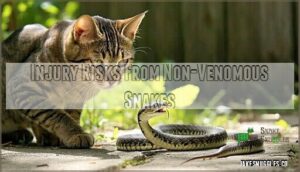This site is supported by our readers. We may earn a commission, at no cost to you, if you purchase through links.

Wild breeds like black-footed cats boast a 60% hunting success rate, while your pampered house cat might find a garden snake more challenging than expected. Larger, experienced cats usually outperform their smaller counterparts—adult males pack 36% more weight and stronger bites.
But here’s the kicker: even skilled feline hunters face serious risks from venomous strikes and constriction injuries that could turn the tables faster than you’d think.
Table Of Contents
- Key Takeaways
- Can All Cats Kill Snakes?
- How Do Cats Hunt and Kill Snakes?
- What Types of Snakes Can Cats Kill?
- What Are The Risks for Cats Fighting Snakes?
- How to Keep Your Cat Safe From Snakes
- What to Do if Your Cat Encounters a Snake
- Frequently Asked Questions (FAQs)
- Can cats kill snakes?
- Can cats eat snakes after killing them?
- Does a cat attack a snake?
- Can a cat die after fighting with a snake?
- Can cats keep snakes away?
- Can a cat catch a snake?
- Is it normal for cats to kill snakes?
- Does having a cat keep snakes away?
- Who will win between a cat and a snake?
- Do cats know to stay away from snakes?
- Conclusion
Key Takeaways
- Cat hunting success varies dramatically – Wild breeds like black-footed cats achieve 60% hunting success rates, while house cats average only 32%, with factors like breed, size, age, and experience determining whether your feline will engage with or successfully catch snakes.
- Venomous snakes pose serious deadly risks – Even skilled cat hunters face life-threatening dangers from venomous strikes that can cause paralysis, organ failure, or death within hours, though cats survive venomous bites at twice the rate of dogs due to slower blood coagulation.
- Quick veterinary care saves lives – With immediate antivenom treatment, cat survival rates jump to 84-97% for venomous snake bites, but without professional care, even non-venomous encounters can lead to dangerous infections or constriction injuries.
- Prevention beats hoping for hunting success – Smart yard maintenance like keeping grass short, removing brush piles, sealing entry points, and supervising outdoor time protects your cat more effectively than relying on their natural snake-catching abilities.
Can All Cats Kill Snakes?
Not every cat can kill a snake—it depends on their hunting instincts, size, and experience. While most cats have natural predatory abilities, factors like breed temperament, age, and individual personality determine whether they’ll actually engage with or successfully catch snakes.
Instinctual Hunting Vs. Learned Behavior
Your house cat carries the same predatory DNA as its wild cousins, making snake hunting less about training and more about flipping an ancient switch that’s been waiting millions of years to activate.
Your house cat’s DNA holds millions of years of predatory instincts, waiting for the right moment to activate ancient snake-hunting programming
It’s really a mix of nature and nurture at work here. Your fluffy companion doesn’t need lessons—those lightning-fast reflexes and stalking behaviors just emerge when the right situations trigger those dormant predator instincts.
Breed, Size, and Age Differences
Size matters when domesticated cats face snakes. Larger breeds like Maine Coons pack more muscle and bite force—about 20% stronger than smaller cats—giving them serious advantages against bigger prey. Age brings experience too, with older cats showing better hunting success than kittens who are still learning the ropes. Cats’ heightened senses help them assess potential snake threats.
Here’s what affects your cat’s snake-hunting abilities:
- Breed Predispositions: Wild breeds like black-footed cats hit 60% hunting success, while house cats average 32%
- Size Advantages: Adult males are 36% heavier with stronger bites, handling snakes up to 100 grams
- Age Experience: Older cats capture larger prey thanks to refined skills and muscle control
- Regional Variations: Outdoor cats in snake-heavy areas like Australia average 225 reptile kills annually
Even small cats can surprise you—size isn’t everything in these showdowns.
Limits of Domestic Cats’ Abilities
Even the fiercest feline hunter meets their match when physics and biology collide—your tabby might’ve lightning reflexes, but they’re still working with house cat hardware against some seriously dangerous opponents.
When you’re talking life-and-death encounters, size becomes everything. Take rattlesnakes—cats have zero venom resistance built in, and there’s no quick tutorial for surviving nature’s most lethal serpents.
How Do Cats Hunt and Kill Snakes?
When cats encounter snakes, they don’t charge in blindly—they use lightning-fast reflexes and calculated moves that would make a chess master jealous.
Your feline friend employs specific hunting tactics, from the classic "pounce and retreat" dance to targeting vulnerable spots, though their approach changes dramatically depending on whether they’re facing a harmless garden snake or something with fangs.
Hunting Techniques and Tactics
When a cat spots a snake, it becomes a master strategist, using techniques that would make any military tactician proud.
Your feline employs herding behavior, circling the snake to prevent escape while maintaining strike evasion distance.
Cats rely on pure instinct here, using their paws like little boxing gloves to wear down the snake before going for the kill shot at the neck.
It’s hunting 101—test your enemy’s reflexes, tire them out, then strike where it counts.
Reflexes and Physical Abilities
Lightning-fast reflexes turn your average house cat into a strike-dodging ninja when facing off against a serpent. With reaction times hitting 100-120 milliseconds, your cat’s agility lets them weave around danger while their claws and precision swatting technique keep them just out of harm’s reach.
This instinctual precision transforms even gentle house cats into focused predators.
Targeting Non-Venomous Vs. Venomous Snakes
Clever cats usually choose their battles wisely when it comes to snake encounters. Your feline friend will usually target smaller, non-venomous species like garter snakes rather than risking a fight with dangerous opponents. Here’s what influences their hunting decisions:
- Size matters – Cats avoid larger venomous snakes, preferring smaller prey they can handle safely
- Encounter frequency peaks during warmer months when snake activity increases
- Hunting success rates show cats kill non-venomous snakes more often than venomous ones
Notably, feral cats demonstrate greater feral resilience against snake bites, surviving venomous encounters at twice the rate of dogs in cat and snake interactions. This is partially because cats exhibit slower blood coagulation, giving them a survival advantage.
What Types of Snakes Can Cats Kill?
Your cat’s hunting success depends heavily on the type of snake they encounter. Non-venomous species, like rat snakes and garter snakes, are generally safe for cats to handle.
However, venomous snakes present serious dangers that can quickly turn deadly.
Non-Venomous Snake Encounters
Most house cats handle harmless snakes like garter snakes and rat snakes with surprising confidence, treating them almost like oversized, slow-moving toys.
Your house cat’s natural defenses kick in during these encounters, using quick swats and agile movements for safe handling.
Non-venomous snakes can’t seriously harm cats, making snake identification important for understanding when your pet’s behavior changes signal a manageable situation.
Venomous Snakes and Risk Assessment
Here’s where things get dangerous—venomous snakes turn your cat from predator into potential victim faster than you can blink. Venom potency varies dramatically, but even smaller venomous species can overwhelm your cat’s system.
Risk factors include:
- Bite location – neck and face bites are most dangerous
- Snake size – larger snakes deliver more venom
- Cat’s body weight – smaller cats face higher risks
- Antivenom access – rural areas have limited treatment options
- Regional threats – know your local venomous species
Snake bite symptoms in cats require immediate veterinary care.
Regional Snake Species and Cat Interactions
Where you live makes a huge difference. In Australia, cats are absolute killers when it comes to native snakes—they wipe out over 650 million reptiles every year. Compare that to Texas, where rattlesnakes don’t face nearly the same pressure from house cats as Australia’s gopher snakes do.
Snakes have learned to adapt though. They’re spending way more time in hiding spots, which changes how often they bump into people depending on where you are.
What Are The Risks for Cats Fighting Snakes?
While cats are skilled hunters, tangling with snakes puts them at serious risk—especially when venomous species are involved.
Even non-venomous snakes can deliver painful bites and injuries that require medical attention.
Venomous Snake Bites and Symptoms
When a venomous snake sinks its fangs into your cat, you’re looking at a medical emergency that can unfold in minutes, not hours. Venom toxicity levels vary dramatically between species, but bite severity factors like fang penetration depth and envenomation amount determine your cat’s fate.
Watch for rapid symptom progression: facial swelling, dilated pupils, weakness, and paralysis. Even dry bites require immediate first aid measures and veterinary care to prevent long-term effects.
Injury Risks From Non-Venomous Snakes
Just because a snake doesn’t pack venom doesn’t mean your cat walks away from the fight unscathed. Non-venomous snakes can still deliver painful bites that risk infection potential if bacteria enters puncture wounds.
Larger constrictors pose constriction injuries to smaller cats, while defensive strikes may cause scarring risks around sensitive areas like eyes.
Even minor encounters can trigger psychological trauma, making your cat wary of future outdoor adventures.
Survival Rates and Bite Outcomes
Your cat’s chances of surviving a snake bite depend heavily on the species involved and how quickly you act. Cats actually handle venomous snake encounters better than dogs in many cases. Here’s what the data shows about survival rates:
- Antivenom Effectiveness: With immediate treatment, cat survival jumps to 84-97% for brown or tiger snake bites
- Hospitalization Length: Most cats recover within 1-2 days when given proper veterinary care
- Neurological Deficits: About 94% show muscle weakness, but bleeding occurs in only 5% of cases
- Coagulation Normalization: Blood clotting issues usually resolve within 24 hours of treatment
- Long-Term Effects: Surviving cats rarely have lasting problems and return to normal activities within weeks
Without antivenom, eastern brown snake bites still leave cats with a 66% survival rate—much better than the 31% for dogs.
The predator-prey relationship between cats and snakes has shaped feline resilience over thousands of years. Quick veterinary intervention makes all the difference in cat health outcomes during these dangerous animal combat situations.
How to Keep Your Cat Safe From Snakes
While cats are natural-born snake hunters, that doesn’t mean you should let them face off with every slithering visitor in your yard.
Smart prevention beats hoping your furry friend’s hunting instincts will keep them safe from venomous bites.
Preventing Outdoor Snake Encounters
Your best defense against snake encounters starts before you ever open that back door. Smart yard maintenance eliminates hiding spots—keep grass short and remove brush piles where snakes love to lurk. Consider deterrent plants like marigolds around your property’s perimeter.
For high-risk areas, snake fencing creates a physical barrier. Always plan supervised outings during daylight hours when you can spot potential threats and keep your feline friend safe.
Snake-Proofing Your Home and Yard
Think of your property as a fortress—but instead of keeping out medieval armies, you’re creating barriers that make snakes think twice about setting up camp in your backyard.
Start with yard maintenance—trim tall grass, remove brush piles, and clear debris where snakes love to hide. Seal entryways around your home’s foundation, garage doors, and crawl spaces.
Plant deterrent plants like marigolds or consider snake fencing for high-risk areas.
Supervising Cats and Recognizing Snake Habitats
Knowing where snakes like to hang out is half the battle when you’re keeping your feline friend safe from slithery surprises. Watch for these prime snake hangouts during supervised outings:
- Woodpiles and brush heaps – Dark, cool spots where rodents gather
- Rock crevices and stone walls – Perfect hiding places for snake activity
- Tall grass near water sources – Prime hunting grounds requiring early intervention
Create safe zones by clearing debris and maintaining proper habitat identification.
What to Do if Your Cat Encounters a Snake
When your cat faces off with a snake, quick action can mean the difference between a close call and a veterinary emergency.
Knowing what to watch for and how to respond immediately protects your feline friend from potentially life-threatening consequences.
Immediate Actions After a Snake Bite
Time becomes your enemy the moment you spot your cat stumbling away from a snake encounter. Identify symptoms like swelling, dilated pupils, or weakness—these signal urgent trouble.
Don’t panic, but seek immediate care. Keep your cat calm and still during transport to prevent venom spread. Skip home remedies; professional antivenom treatment prevents devastating long-term effects.
Veterinary Care and Antivenom Treatment
How quickly should you rush to the vet after a snake bite? Professional veterinary care becomes critical within hours, not days. Antivenom treatment shows striking efficacy—100% survival rates for coral snake bites when administered properly.
Your vet will focus on four main areas of treatment:
- Antivenom administration – usually 1-2 vials within 6 hours for best outcomes
- Supportive care – IV fluids, pain management, and wound cleaning to prevent infection
- Blood monitoring – checking for coagulopathy and other snake venom complications
- 24-hour observation – tracking snake bite symptoms and treatment response
Treatment costs range from $1,320-$6,396 per vial, but early intervention prevents serious complications like kidney injury.
Monitoring and Recovery Steps
After your vet visit, the real work begins at home—recovery isn’t just about watching and waiting, it’s about becoming your cat’s personal health detective.
Watch for changes in eating, drinking, or bathroom habits. Keep wounds clean and dry while monitoring for infection signs like swelling or discharge.
Pain management through prescribed medications helps your furry friend heal faster and more comfortably.
Frequently Asked Questions (FAQs)
Can cats kill snakes?
Lightning-fast reflexes meet ancient instinct when your feline encounters a slithering predator. Cats can kill snakes through remarkable agility, impact, and razor-sharp hunting success factors, though snake size matters greatly in determining outcomes.
Can cats eat snakes after killing them?
While cats instinctively hunt snakes, eating them poses serious risks. This learned behavior in the predator-prey relationship can lead to dangerous consequences:
- Parasite risks from consuming infected snake tissue
- Toxin accumulation from venomous species, even when dead
- Digestive concerns due to bones and poor nutritional value
Smart animal behavior involves avoiding consumption after the kill.
Does a cat attack a snake?
When Luna spotted the garden snake near her food bowl, her pupils dilated and she dropped into a hunting crouch—classic predator-prey relationship dynamics at work.
Yes, cats do attack snakes, driven by instinct versus training patterns hardwired into their DNA. These hunting motivations trigger herding behavior where your cat circles the snake, initiating the fight through calculated swats and strategic positioning.
Can a cat die after fighting with a snake?
Unfortunately, yes—venomous snake bites can be fatal to cats. Snakebite severity depends on several critical factors that determine your cat’s survival chances:
- Venom toxicity and snake species – Some venoms cause rapid paralysis or organ failure
- Bite location on your cat’s body – Head and neck bites are most dangerous
- Treatment availability and timing – Quick veterinary care dramatically improves outcomes
Cat size matters too. Smaller cats face higher risks from the same venom dose. Without prompt treatment, venomous snake bites can cause long-term effects or death.
Even non-venomous snakes can inflict serious wounds. Cat health and safety should always come first—never let your cat hunt snakes unsupervised.
Can cats keep snakes away?
When Sarah noticed fewer garden snakes after adopting her tabby, Max, she wondered if his presence was actually deterring them.
While cats can catch snakes, their effectiveness as snake deterrents has limited effectiveness. Cat presence and scent marking may discourage some snakes through territory defense, but dedicated snake repellent technology works better.
Can a cat catch a snake?
Cats possess impressive snake-catching abilities thanks to their lightning-fast reflexes and razor-sharp hunting instincts. Even domesticated cat breeds retain these predator-prey relationship skills, with young cats’ abilities often surprising their owners.
Here are five key hunting success factors that boost cats’ kill rate against snakes:
- Lightning reflexes – Cats react 100-120 milliseconds faster than most snakes can strike
- Instinct and precision – They naturally target the snake’s head and neck for quick kills
- Agility advantage – Cats dodge, circle, and "herd" snakes to control the encounter
- Paw-swatting technique – They maintain a safe distance while wearing down their prey
- Persistent focus – Cat behavior with snakes shows striking patience and determination
Your house cat’s ancestors didn’t survive by backing down from slithery challenges!
Is it normal for cats to kill snakes?
Your tabby might surprise you—like when Max cornered a rattlesnake in his Arizona backyard last summer.
Snake-catching isn’t rare behavior for cats. Their predator-prey relationships and hunting instincts make this normal, especially where snake abundance is high.
Does having a cat keep snakes away?
While cat presence can create some snake avoidance through predator scent marking and territory control, it offers limited deterrence.
Snake behavior adapts over time, and cats aren’t reliable snake repellent solutions for homeowners.
Who will win between a cat and a snake?
While cats possess remarkable reflexes and agility, the outcome of cat-snake dominance depends on multiple factors rather than guaranteeing one clear winner in these predator-prey relationships.
What actually decides who wins these encounters:
- Snake advantages – Venomous species like rattlesnakes deliver potentially fatal bites, while constrictors use powerful coils
- Cat advantages – Lightning-fast reflexes (100-120 milliseconds), enhanced agility, and natural snake catching abilities give cats the edge
- Size matters – Larger snakes overpower smaller cats, while tiny snakes fall prey to even young kittens
- Experience counts – Seasoned outdoor cats develop better tactics for cat vs rattlesnake comparison scenarios than sheltered indoor pets
Do cats know to stay away from snakes?
Most domestic cats lack a natural snake avoidance instinct. Their feline risk assessment prioritizes hunting over danger, making snake encounter experience important for developing learned snake behavior and survival skills around venomous species.
Conclusion
Funny how nature works—while you’re reading about feline hunters, your neighbor’s cat might be eyeing a snake right now. Can a cat kill a snake?
All cats always possess hunting instincts, but success isn’t guaranteed. Your furry friend’s age, breed, and experience matter more than raw courage.
Remember, even victorious cats face serious injury risks. Keep your kitty safe by snake-proofing your yard and staying vigilant during outdoor adventures.
- https://science.anu.edu.au/news-events/news/hidden-toll-australias-cats-kill-almost-650-million-reptiles-year
- https://www.frontiersin.org/journals/veterinary-science/articles/10.3389/fvets.2021.731689/full
- https://www.petscare.com/news/post/do-cats-eat-snakes-guide
- https://eeg.expert/blog/cats-snakes-and-reaction-times
- https://a-z-animals.com/animals/comparison/cat-vs-rattlesnake/















